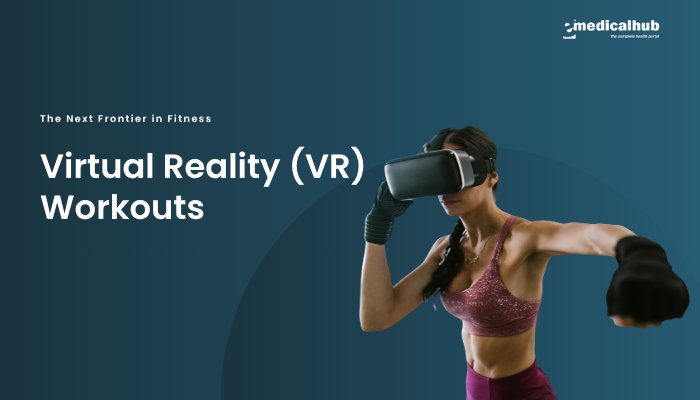Introduction
Virtual Reality (VR) is revolutionizing many aspects of our lives—from gaming and education to healthcare and fitness. In recent years, VR workouts have emerged as an innovative and immersive way to exercise, blending technology with physical activity to create engaging fitness experiences.
These workouts promise to transport you to scenic virtual landscapes, simulate competitive sports, and offer interactive coaching—all from the comfort of your home or gym. But do VR workouts truly deliver measurable fitness benefits? Are they a sustainable alternative to traditional exercise methods? And how safe and effective are they for various fitness levels?
This article delves into the evolving world of VR workouts, exploring the technology behind them, their potential health and motivational benefits, and key safety tips for getting started. Whether you’re a tech enthusiast, a fitness newbie, or someone seeking a fresh way to break through exercise plateaus, read on to discover why VR might be the next frontier in fitness.
Disclaimer: The content in this article is intended for educational purposes only and does not replace professional medical or fitness advice. If you have underlying health conditions or concerns about starting a new exercise regimen, please consult a qualified healthcare provider.
What Are Virtual Reality Workouts?
Defining VR Workouts
Virtual Reality workouts use immersive technology to create a simulated environment in which you exercise. Instead of staring at a blank wall or a television screen, you wear a VR headset that transports you into a virtual setting—be it a peaceful forest, a bustling urban landscape, or a futuristic gym. The experience is interactive: your movements are tracked, and the virtual world responds in real time.
- Immersive Environment: The headset displays 360-degree visuals, while spatial sound enhances the experience.
- Interactive Tracking: Motion sensors and controllers capture your movements to replicate actions like running, cycling, or strength exercises.
- Feedback and Coaching: Many VR fitness platforms offer real-time feedback, guided workouts, and performance metrics.
Evolution of VR in Fitness
While VR began primarily in gaming, its application to fitness has grown due to several factors:
- Technological Advancements: Improvements in resolution, tracking accuracy, and ergonomic design have made VR headsets more accessible and comfortable.
- Increased Affordability: As production costs decrease, quality VR devices are becoming available to a broader audience.
- Integration with Fitness Trends: With the rise of home workouts and remote training post-pandemic, VR offers a novel, engaging way to exercise without the constraints of a traditional gym.
How VR Workouts Differ from Traditional Exercise
Traditional workouts often rely on repetitive motion and can feel monotonous over time. VR workouts, however, incorporate game-like elements and varied virtual scenarios, which can:
- Boost Engagement: Interactive challenges and virtual environments keep the mind engaged and may distract from fatigue.
- Enhance Motivation: Achievements, scores, and progress tracking within the VR platform can drive consistency.
- Provide Variety: Workouts can be varied from day to day, preventing boredom and ensuring that different muscle groups are challenged.
Health and Fitness Benefits of VR Workouts
Physical Benefits
Cardiovascular Improvements
- Increased Heart Rate: High-intensity VR workouts can elevate your heart rate similar to traditional aerobic exercise.
- Enhanced Endurance: Over time, regular sessions can improve cardiovascular endurance, mirroring benefits seen in outdoor running or cycling.
Strength and Flexibility
- Functional Movements: Many VR routines incorporate bodyweight exercises like squats, push-ups, and lunges, which build strength and improve functional fitness.
- Dynamic Stretching and Balance: Some programs integrate yoga and stretching sequences to enhance flexibility and balance.
Calorie Burn and Weight Management
- High-Intensity Intervals: VR workouts often mimic HIIT protocols, promoting calorie burn and fat oxidation in shorter time spans.
- Engaging Formats: The immersive nature encourages users to push harder, potentially increasing overall energy expenditure.
Mental and Psychological Benefits
Stress Reduction and Mood Enhancement
- Escapism and Relaxation: Immersing in a virtual world can distract from daily stressors, reducing cortisol levels and fostering relaxation.
- Mind-Body Connection: The interactive and engaging nature of VR can improve focus and mindfulness, similar to meditation practices.
Cognitive Benefits
- Enhanced Concentration: Navigating complex virtual environments may improve cognitive function and spatial awareness.
- Memory and Learning: The novelty and interactivity of VR can stimulate brain areas related to learning and memory.
Social and Motivational Benefits
Community Engagement
- Virtual Group Classes: Many platforms offer multiplayer or live-streaming sessions, creating a sense of community and accountability.
- Competitive Elements: Leaderboards, challenges, and shared progress can foster healthy competition and motivate regular participation.
Gamification and Enjoyment
- Fun Factor: By turning workouts into games or adventures, VR can make exercise enjoyable, encouraging consistency.
- Personalized Challenges: Adaptive programs tailor difficulty to individual fitness levels, keeping workouts challenging yet achievable.
Popular VR Workout Platforms and Programs
VR Fitness Apps and Systems
- Supernatural: Offers guided workouts set in stunning, real-world-inspired virtual environments. Focuses on HIIT, meditation, and full-body exercises.
- FitXR: Provides virtual classes that combine boxing, dance, and high-intensity workouts, with a variety of music and visual themes.
- Beat Saber: Although primarily a rhythm game, it provides an excellent cardio workout by requiring quick, dynamic movements.
- VZfit: Integrates with stationary bikes, allowing you to cycle through immersive landscapes while tracking performance metrics.
Hardware Options
- VR Headsets: Oculus Quest 2 (Meta Quest 2), HTC Vive, PlayStation VR – devices that offer high-quality visuals and interactive tracking.
- Connected Equipment: Some platforms integrate with smart exercise machines (e.g., stationary bikes, treadmills) for a more comprehensive fitness experience.
- Wearables: Combining VR with wearable fitness trackers or heart rate monitors can enhance data accuracy and personalized feedback.
Potential Drawbacks and Safety Considerations
Physical Safety
Risk of Injury
- Space Limitations: Working out in confined spaces can lead to accidental collisions or trips. Ensure your workout area is clear.
- Overexertion: The immersive experience can sometimes make it easy to push too hard, risking muscle strains or joint injuries.
- Balance Issues: VR’s visual immersion might disrupt your balance, particularly on uneven surfaces or during dynamic movements.
Mitigation Strategies
- Clear Workout Area: Remove obstacles and designate a safe space for VR exercise.
- Start Slow: Beginners should begin with lower-intensity sessions and gradually increase difficulty.
- Use Safety Gear: Consider supportive footwear and, if necessary, a wrist strap or controller safety tether.
- Take Breaks: Regularly pause to check in with your body and avoid overtraining.
Technology-Related Concerns
Cost and Accessibility
- Upfront Investment: Quality VR headsets and compatible equipment can be expensive.
- Subscription Fees: Many apps require monthly or annual subscriptions, adding to the cost.
- Technical Issues: Glitches, battery life, and software updates can interrupt workouts.
User Experience and Comfort
- Motion Sickness: Some individuals may experience VR-induced nausea or dizziness.
- Learning Curve: Navigating virtual interfaces can be challenging initially.
- Isolation: While some enjoy virtual group workouts, others might miss the social dynamics of in-person classes.
How to Get Started with VR Workouts
Assess Your Fitness Level and Goals
- Beginner-Friendly Programs: If you’re new to exercise or VR, start with low-intensity or beginner-specific workouts.
- Define Goals: Decide if your focus is on cardio, strength, flexibility, or a mix, and choose a program that aligns with your objectives.
- Consult a Professional: Particularly if you have preexisting health conditions, get a doctor’s approval before starting intense VR workouts.
Setting Up Your Space
- Clear Area: Designate a space free from obstacles where you can move safely.
- Comfortable Setup: Ensure your headset fits well and the room has enough lighting to avoid disorientation when taking breaks.
- Safety Accessories: Use a mat for stability if you’re doing floor exercises.
Choosing the Right Equipment and App
- Research Devices: Look for headsets with good resolution, tracking, and ease of use. Reviews and comparisons can help you select the best option.
- Trial Runs: Many apps offer free trials. Test a few to see which interface and workout style you prefer.
- Integration with Wearables: Consider whether you want to pair your VR experience with a heart rate monitor or fitness tracker for extra data.
Building a Routine
- Schedule Regular Sessions: Aim for 2–3 VR workouts per week as a starting point, and gradually increase as your comfort and fitness improve.
- Mix It Up: Vary workouts to cover different modalities (cardio, strength, flexibility) and prevent boredom.
- Track Progress: Use in-app metrics and a personal workout journal to record improvements in performance and how you feel.
Maximizing Your VR Workout Experience
Enhance Engagement and Motivation
- Set Personal Challenges: Many platforms allow you to set goals or compete with friends virtually, adding a competitive edge.
- Reward Systems: Use milestones (e.g., total distance, calories burned) to reward yourself with non-food incentives.
- Social Connectivity: Join online communities or virtual workout groups for accountability and shared motivation.
Integrate Mindfulness and Recovery
- Mindful Movement: Even during high-intensity sessions, focus on your breathing and body movements to enhance the mental benefits.
- Recovery Protocols: Follow up intense sessions with cool-down routines, stretching, or yoga to facilitate recovery.
- Sleep and Nutrition: Support your workouts with adequate rest and a balanced diet, ensuring your body recovers and adapts.
Balancing VR with Traditional Exercise
- Hybrid Programs: Combine VR workouts with outdoor or gym-based exercises to maintain variety and challenge your body in multiple ways.
- Cross-Training: Use VR workouts as a complement to strength training or aerobic sessions, not as a sole exercise modality.
Real-World Success Stories
Urban Professional Transformation
A 32-year-old urban professional with a hectic schedule incorporated three 20-minute VR workouts per week using a popular platform. Initially drawn to the immersive environments, she gradually found that the engaging workouts helped lower her stress levels and improve her cardiovascular endurance. Over six months, she reported better sleep quality, increased energy during work hours, and noticeable improvements in her overall mood.
Retiree’s Journey to Mobility
A 68-year-old retiree, who previously felt isolated due to limited mobility, discovered VR cycling classes that allowed him to simulate scenic rides along coastlines and through forests. The interactive, low-impact exercise helped improve his balance and leg strength, while the virtual social setting kept him motivated. His improved mobility even translated to easier daily activities like climbing stairs and walking longer distances.
Competitive Athlete’s Integration
An amateur triathlete in his 40s added VR high-intensity interval training sessions on non-training days to his regular cycling and running regimen. The VR workouts offered variety and a mental break from traditional training. The athlete noted that the immersive challenges helped him maintain motivation and provided useful data on heart rate variability, which he used to adjust recovery protocols. This cross-training method contributed to improved overall performance and reduced burnout.
Frequently Asked Questions (FAQ)
Do I need expensive equipment for VR workouts?
While high-end VR systems offer advanced features, many affordable options on the market provide a quality workout experience. Look for devices with good reviews regarding tracking and comfort.
Can VR workouts replace all my traditional exercise routines?
VR workouts can be a valuable complement, but a balanced fitness program should also include strength, flexibility, and possibly outdoor aerobic exercise. Use VR as one component of a holistic approach.
How do I overcome motion sickness in VR workouts?
If you experience dizziness or nausea, start with shorter sessions and gradually increase duration. Ensure your device is properly calibrated, and consider taking breaks during intense sessions. Choosing activities with minimal rapid movement can also help.
Are VR workouts safe for beginners?
Yes, many platforms offer beginner-friendly workouts. However, if you have any underlying health issues, consult your doctor before starting. Begin with lower-intensity sessions and focus on proper form and gradual progression.
Can I track my performance accurately with VR?
Modern VR systems often integrate metrics like heart rate, calories burned, and distance covered. Although some measurements may vary, they are useful for tracking trends over time rather than precise values.
What types of workouts are available in VR?
There’s a wide variety, including cardio, HIIT, yoga, boxing, dance, and strength training. Many platforms allow you to choose based on your goals and fitness level.
How do I ensure my workout space is safe for VR exercises?
Clear a dedicated area free of obstacles, secure cables and furniture, and use a soft mat if needed. Consider using a safety tether or boundary system if your VR device offers one.
Will VR workouts keep me motivated long-term?
Many users find the immersive experience and variety of virtual environments motivating. However, motivation can vary among individuals, so consider mixing VR with other forms of exercise.
Can VR workouts help improve my mental health?
Yes, engaging with nature-inspired virtual environments and interactive sessions has been linked to reduced stress and improved mood. The combination of physical activity and immersive experiences can be particularly beneficial for mental well-being.
How do VR workouts compare to traditional gym classes?
VR workouts offer similar benefits to gym classes, with the added advantage of immersive, engaging environments that can reduce boredom. However, the social interaction and direct coaching of in-person classes might be preferable for some individuals.
Conclusion
Virtual Reality workouts represent an exciting evolution in the fitness world. They merge cutting-edge technology with physical exercise to provide engaging, interactive, and often immersive workout experiences. From boosting cardiovascular health and burning calories through high-intensity interval training to offering calming, meditative environments for yoga and mindfulness, VR workouts cater to a broad spectrum of fitness needs.
While the technology continues to improve—with advances in sensor accuracy, AI-driven coaching, and ergonomic design—VR workouts remain a promising tool for those seeking variety, convenience, and motivation in their fitness routines. It’s important to remember that, like any workout method, they are most effective when integrated into a balanced exercise program that includes strength training, flexibility work, and proper recovery.
For beginners, starting with low-intensity sessions and gradually progressing is key, as is ensuring a safe, clutter-free space. For advanced users, the real-time feedback and immersive challenges can drive new levels of performance. And for everyone, the mental health benefits of exercising in virtual nature or dynamic, engaging settings add a valuable dimension to overall well-being.
Ultimately, VR workouts offer a glimpse into the future of fitness—one that harnesses technology to make exercise more engaging, accessible, and enjoyable. Whether you’re a tech enthusiast or simply looking for a change from routine gym sessions, exploring VR fitness could be the next step on your journey toward a healthier, more active life.
References
- Rizzo AS, Koenig ST. Is clinical virtual reality ready for primetime? Neuropsychology. 2017;31(8):877-899.
- Gao Z, et al. The effectiveness of virtual reality exercise in improving health outcomes: a systematic review and meta-analysis. J Sport Health Sci. 2021;10(1):1-12.
- Li A, Montano Z, Chen VJ, Gold JI. Virtual reality and pain management: current trends and future directions. Pain Manag. 2017;7(4):225-233.
- Finkelstein EA, et al. The role of wearable technology in improving exercise adherence: A review. J Sports Sci. 2020;38(15):1755-1763.
- Kooiman TJ, Dontje ML, Sprenger SR, et al. Reliability and validity of ten consumer activity trackers. BMC Sports Sci Med Rehabil. 2015;7:24.
- Borghese N, et al. Heart rate variability and recovery following high-intensity interval training: a systematic review. Sports Med. 2020;50(6):1019-1032.
- Voinescu A, et al. Virtual reality-based exercise: benefits and challenges. Phys Ther Rev. 2021;26(3):139-148.
- Laver KE, et al. Virtual reality for stroke rehabilitation. Cochrane Database Syst Rev. 2017;11:CD008349.
- Hwang R, et al. The use of virtual reality in the treatment of psychiatric disorders: a systematic review. J Clin Psychiatry. 2019;80(6):18m12186.
- Miller JD, et al. The impact of immersive virtual environments on exercise motivation and enjoyment. J Sport Exerc Psychol. 2021;43(1):37-46.
- Paquay L, et al. The psychological and physical benefits of nature-based exercise. Int J Environ Res Public Health. 2020;17(18):6617.
- U.S. Department of Health and Human Services. Physical Activity Guidelines for Americans, 2nd edition. 2018.





